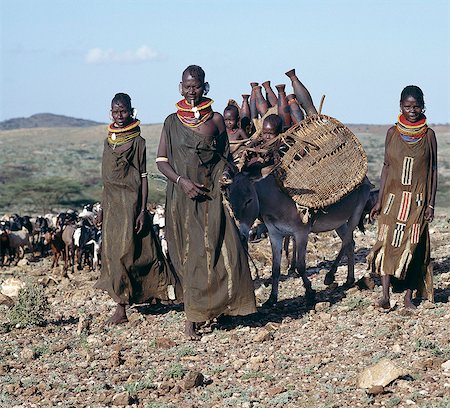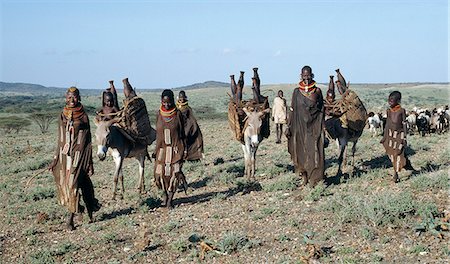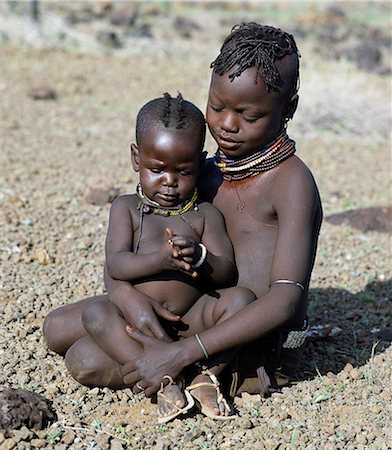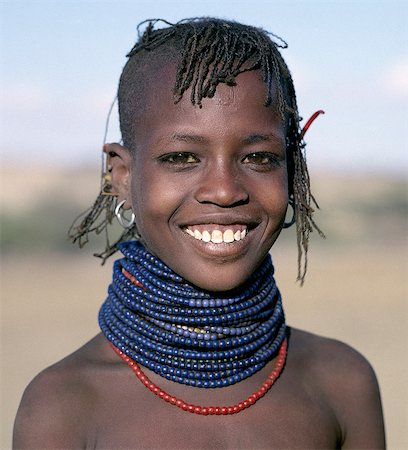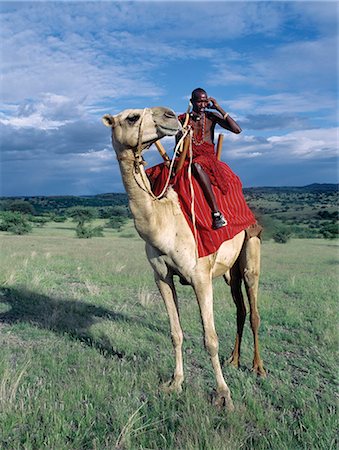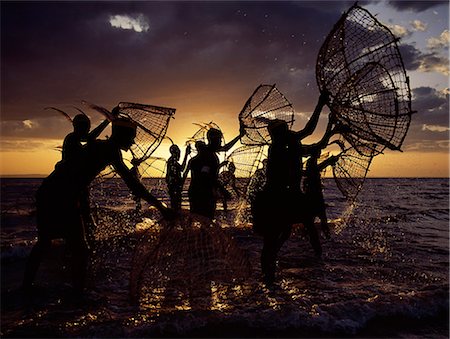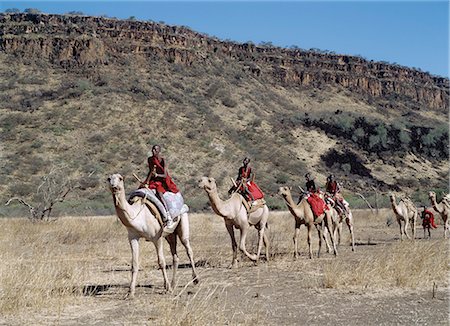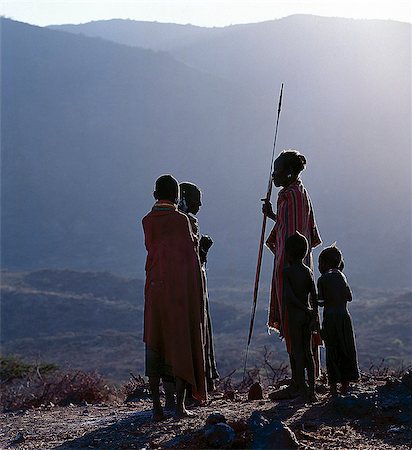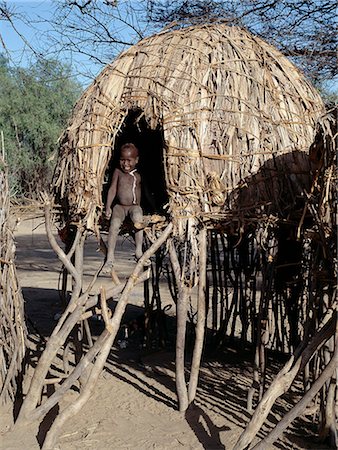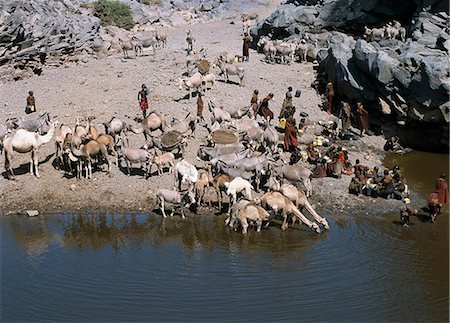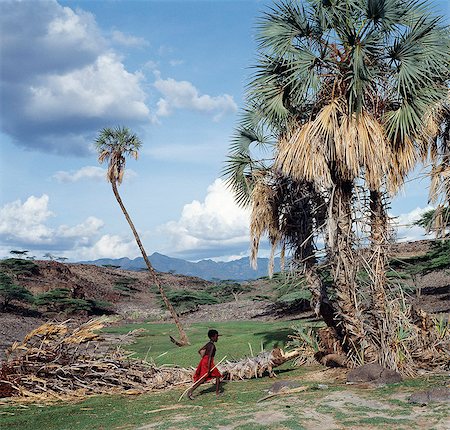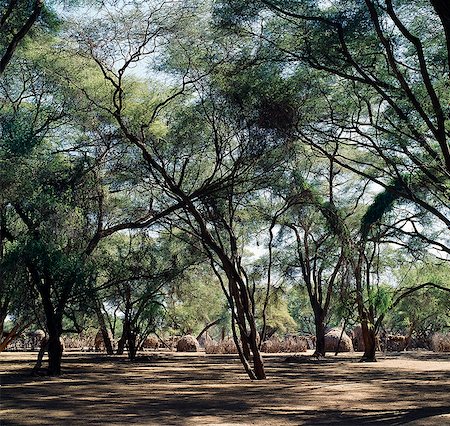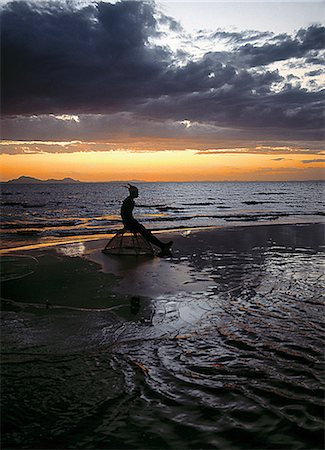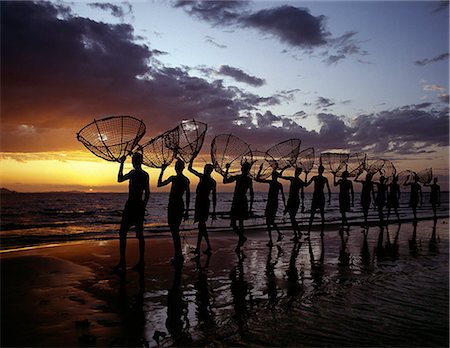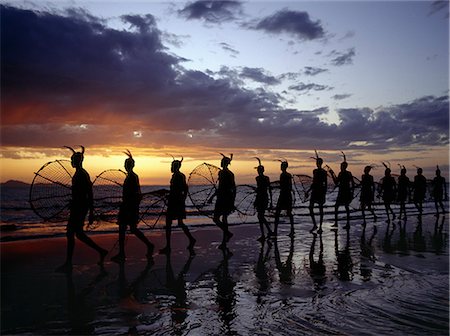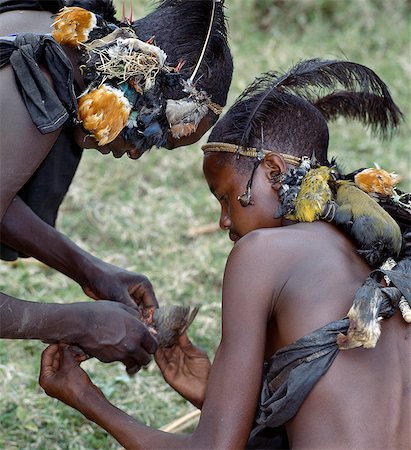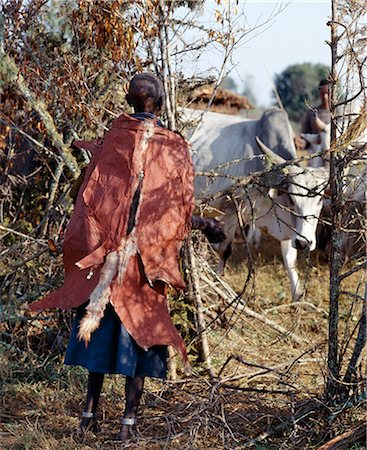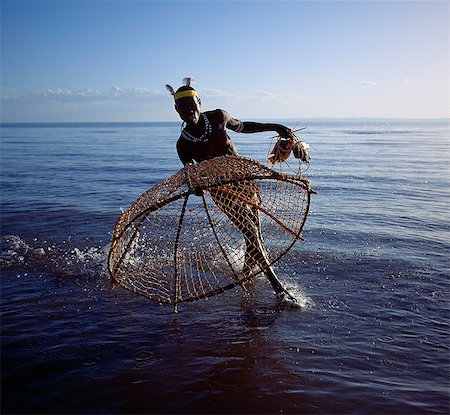-
Donkeys are indispensable beast of burden,assuring the nomadic Turkana of complete mobility. These study little animals carry the few essentials of life in oval panniers strapped to their flanks. Infants,puppies and newborn kids will also ride securely in them. The skittle-shaped containers are used for milk and water.
Rights-Managed
-
Donkeys are indispensable beast of burden,assuring the nomadic Turkana of complete mobility. These study little animals carry the few essentials of life in oval panniers strapped to their flanks. Infants,puppies and newborn kids will also ride securely in them. The skittle-shaped wooden containers are used for milk and water.
Rights-Managed
-
Turkana girls return home from a Waterhole with water containers made of wood. Their cloaks are goatskin embellished with glass beads.
Rights-Managed
-
When a Turkana woman gives birth,four goats will be slaughtered in a twenty-four-hour period to celebrate the occasion. The skin of the first goat will be made into a pouch for carrying the baby on its mother's back. The small wooden balls on the back of this pouch are charms to ward off evil spirits. The baby is wearing a bracelet of ostrich eggshell beads.
Rights-Managed
-
Childhood is brief in nomadic communities. From an early age,Turkana girls help their mothers with the household chores and look after their younger brothers and sisters during the day. The baby has wooden charms round her neck to ward off evil spirits.
Rights-Managed
-
A proud Turkana father and his young daughter. Both their hairstyles are typical of tribal custom in the west of Turkanaland.
Rights-Managed
-
A Turkana girl in all her finery. Among the Turkana,cicatrization is a common form of beautification. She wears a crucifix given to her by a missionary; they are popular ornaments despite not necessarily being associated with Christianity.
Rights-Managed
-
Two Turkana girls set off to fetch water from a nearby Waterhole. Their water containers are made of wood by the women of the tribe. Their 'V' shaped aprons are made of goatskin and have been edged with hundreds and hundreds of round discs fashioned out of ostrich eggshells.
Rights-Managed
-
In the semi-arid terrain of Turkanaland,women have to travel great distances to collect firewood. Like other Nilotic people,Turkana women balance heavy loads on their heads with graceful carriage and poise. The attire of this woman is typical of married women in the tribe.
Rights-Managed
-
Turkana women and girls are responsible for watering livestock,which is unusual among pastoral societies. Here,a young girl waters goats from a waterhole dug in the sand of a seasonal watercourse. Her young brother will control the flow of stock to the water trough. In the background,a man digs out another waterhole; they have to been deepened regularly towards the end of the dry season.
Rights-Managed
-
Turkana women and girls are responsible for watering livestock,which is unusual among pastoral societies. Here,a girl waters cattle from a Waterhole dug in the sand of a seasonal watercourse. The Turkana manipulate the horns of their ox's into perfect symmetry or any whimsical shape that takes the owner's fancy.
Rights-Managed
-
Song is an art form ingrained in Turkana culture. After months of separation,young men and girls gather together during the rains when grass is abundant and life is relatively easy for a while. The Turkana have a rich repertoire of at least twenty dances,most of which are quite energetic.
Rights-Managed
-
Song is an art form ingrained in Turkana culture. At the end of a dance session,the participants invariably enjoy the Song of the Bulls. Each young man will take centre-stage to extol the praises of his favourite ox. He will explain how it came into his possession,its distinguishing traits and with outstretched arms,imitate the shape of its horns.
Rights-Managed
-
A young Turkana girl wearing an attractively beaded leather apron and belt stands outside her mother's home. Sansevieria or wild sisal lines the lower walls of the house. Cicatrization round the nipples of a girl is not an uncommon form of beautification.
Rights-Managed
-
A young Turkana girl with her head shaved except for a tuft,which is braided. This is the usual hairstyle for women and girls.
Rights-Managed
-
A jovial group of Turkana girls in traditional attire. Their aprons are made of goatskin,either beaded or cut into thin strips before braiding. The two girls in the middle have already had the flesh below their lower lips pierced in readiness for a brass ornament after marriage.
Rights-Managed
-
A Turkana woman wears all the finery of her tribe: brass lip plug,beaded collar decorated with bleached shells of the African land snail,leaf-like ear ornaments and metal earrings from which hang tiny rings of goat horn.
Rights-Managed
-
When the Turkana form temporary stock camps in the dry season,they might have to move again in three or four days' time. Often,families have no time or inclination to build a temporary home. They will make do with a shady tree and sleep on skins spread out on the ground.
Rights-Managed
-
Song is an art form ingrained in Turkana culture. At the end of a dance session,the participants invariably enjoy the Song of the Bulls. Each young man will take centre-stage to extol the praises of his favourite ox. He will explain how it came into his possession,its distinguishing traits and with outstretched arms,imitate the shape of its horns.
Rights-Managed
-
Song is an art form ingrained in Turkana culture. At the end of a dance session,the participants invariably enjoy the Song of the Bulls. Each young man will take centre-stage to extol the praises of his favourite ox. He will explain how it came into his possession,its distinguishing traits and with outstretched arms,imitate the shape of its horns.
Rights-Managed
-
The traditional weaponry of the Turkana warriors consisted of a long-shafted spear with a narrow blade,a small rectangular shield made of giraffe or buffalo hide,a wrist knife worn round the assailant's right wrist and one or two finger knives for gouging out an enemy's eyes. They must have been an awesome sight in full battle cry. Modern arms have now replaced the old ways of fighting.
Rights-Managed
-
A pretty young Turkana girl has already had the flesh below her lower lip pierced in readiness for a brass ornament after her marriage. The rims of her ears have also been pierced and the holes kept open with small wooden sticks.
Rights-Managed
-
A Turkana man drives his donkeys through lava fields as clouds gather above Mount Nyiru.
Rights-Managed
-
The nomadic Turkana move their stock camps frequently in search of better pasture. At the height of the dry season when grazing and water are scarce,they might move every three days.
Rights-Managed
-
Childhood is brief in nomadic communities. From an early age,Turkana girls help their mothers with the household chores,while boys learn to look after the small stock. There are only short periods in a day when children can relax and play.
Rights-Managed
-
A young Turkana girl adorned with necklaces of a style the Southern Turkana prefer to wear.
Rights-Managed
-
A young Turkana girl has had the rims of her ears pierced in seven places and keeps the holes open with small wooden sticks. After marriage,she will hang leaf-shaped metal pendants from each hole.
Rights-Managed
-
A Turkana girl's necklaces are well-oiled with animal fat and glisten in the sun. Occasionally,a girl will put on so many necklaces that her vertebrae stretch and her neck muscles gradually weaken. The partially shaven head is typical of Turkana women and girls.
Rights-Managed
-
A Turkana girl's necklaces are well-oiled with animal fat and glisten in the sun. The use of red ochre has been copied from their Samburu neighbours and is not widespread. Occasionally,a girl will put on so many necklaces that her vertebrae stretch and her neck muscles gradually weaken. The partially shaven head is typical of Turkana women and girls.
Rights-Managed
-
Two Turkana men in traditional attire relax in the heat of the day under a shady tree. Every man will have a wooden stool,which doubles up as a pillow at night to protect his clay hairdo. Men will never sit on the ground; only women and children are permitted to do so.
Rights-Managed
-
A Maasai warrior speaks on his mobile phone from the saddle of his camel near Lake Magadi in Kenyas Rift Valley Province.Mobile phones are a popular method of communicating with family and friends in remote areas of Kenya.
Rights-Managed
-
As the sun rises over Lake Turkana, a group of fishermen fish for tilapia with their traditional fishing baskets in the lakes shallow waters. These traditional methods of fishing are now rare because the introduction of small mesh gillnets has resulted in a marked decline of fish stocks close to the shore.
Rights-Managed
-
A Turkana woman sitting in the doorway of her hut. Her heavy mporro braided necklace identifies her as a married woman. Typical of her tribe,she wears many layers of bead necklaces and a beaded headband.
Rights-Managed
-
A Turkana woman sitting in the doorway of her hut. Her heavy mporro braided necklace identifies her as a married woman. Typical of her tribe,she wears many layers of bead necklaces and a beaded headband.
Rights-Managed
-
A Turkana woman,typically wearing many layers of bead necklaces and a series of hooped earrings with an pair of leaf-shaped earrrings at the front,sits in the entrance to her hut.
Rights-Managed
-
A Turkana woman,typically wearing many layers of bead necklaces and a series of hooped earrings with an pair of leaf-shaped earrrings at the front,sits in the entrance to her hut.
Rights-Managed
-
An old Turkana woman,typically wearing many layers of bead necklaces and a series of hooped earrings with an pair of leaf-shaped earrings at the front.
Rights-Managed
-
Maasai men ride camels in the dry bush country at Olorgasailie,situated between Nairobi and Lake Magadi.
Rights-Managed
-
Maasai men ride camels in the dry bush country at Olorgasailie,situated between Nairobi and Lake Magadi.
Rights-Managed
-
Two Maasai men ride camels near Lake Magadi in Kenya's Rift Valley Province. Although the Maasai do not customarily keep camels,much of the semi-arid land of southern Maasailand is more suited to camels than cattle.
Rights-Managed
-
A Turkana man with a fine clay hairstyle,so typical of the southern Turkana. The black ostrich feather pompoms denote that the man belongs to the ng'imor (black) moiety of his tribe.
Rights-Managed
-
Black ostrich feathers decorate the front part of this Turkana man's traditional clay hairdo. Small metal chains,with or without beads attached to the ends of them,are commonplace ear ornaments.
Rights-Managed
-
Flat-topped acacia trees and dome-shaped Turkana homesteads dot the landscape at Nachola - a semi-arid region with sparse vegetation. Large deposits of petrified wood nearby are evidence of a very different climate and vegetation millions of years ago.
Rights-Managed
-
As the sun rises above the forested peaks of Mount Nyiru,members of a Turkana family chat and plan their day's activities.
Rights-Managed
-
As the sun rises above the forested peaks of Mount Nyiru,members of a Turkana family chat and plan their day's activities outside their domed-shaped homes,which provide scant protection from the elements.
Rights-Managed
-
A young Samburu man leads a donkey carrying the basic structure of a temporary home. The curved sticks will be tied together in a dome and covered with hides and woven mats to form a temporary shelter in a stock camp. Donkeys are widely used by the Samburu as beasts of burden.
Rights-Managed
-
Samburu initiates sing during the month after their circumcision. As their wounds heal, their dances become more energetic. Before long, they imitate the dances of the warriors which, hitherto, they have been forbidden to perform.They spend much of their time wandering in the countryside attempting to kill as many birds as they can with a club and four blunt arrows. When a bird is killed, it is sk
Rights-Managed
-
The Turkana families living near the seasonal Kerio River build their houses on stilts. This innovative style is found nowhere else in Turkanaland but suits the conditions at Lokori where the friable soil becomes a quagmire in heavy rain.
Rights-Managed
-
A Turkana girl with a large gourd-like container used as a receptacle for water or milk. In the absence of gourds,the Turkana carve their containers from soft wood,such as that from the common commiphora species,which thrives in semi-arid country.
Rights-Managed
-
The natural rock pools along the Sirima lugga (seasonal watercourse) are important to the Turkana and their livestock in an otherwise waterless,rocky region at the southern end of Lake Turkana. In a year of average rainfall,water in the deepest pools will last throughout the year. If they dry up,the Turkana resort to using the alkaline water of Lake Turkana.
Rights-Managed
-
The natural rock pools along the Sirima lugga (seasonal watercourse) are important to the Turkana and their livestock in an otherwise waterless,rocky region at the southern end of Lake Turkana. In a year of average rainfall,water in the deepest pools will last throughout the year. If they dry up,the Turkana resort to using the alkaline water of Lake Turkana.
Rights-Managed
-
The natural rock pools along the Sirima lugga (seasonal watercourse) are important to the Turkana and their livestock in an otherwise waterless,rocky region at the southern end of Lake Turkana. In a year of average rainfall,water in the deepest pools will last throughout the year. If they dry up,the Turkana resort to using the alkaline water of Lake Turkana.
Rights-Managed
-
A fresh spring rises at Mawingaten making the place a little oasis in the barren lava country that surrounds it. Mount Kulal is in the background. The palm trees are doum palms (Hyphaene compressa).
Rights-Managed
-
A young Turkana herdsboy sneaks a drink of milk straight from a camel's udder. Camels are important to stockowners in the arid regions of Turkanaland since they are browsers and can be milked up to five times a day
Rights-Managed
-
A young Turkana boy looks pensive as he holds a large gourd. Gourds are less common with the Turkana than the wooden containers their women make; firstly,they are expensive since they have to be brought from afar but more importantly they crack more easily on the move.
Rights-Managed
-
There are no permanent rivers in Turkana land. The Kerio,which rises far to the south of the district,is one of the most important seasonal water courses. It has belts of thick riverine vegetation and large stands of acacia trees which provide essential dry season refuge for people and their stock.
Rights-Managed
-
As the sun rises over Lake Turkana,a lone Turkana fisherman sits on his traditional fishing baskets to await the arrival of his companions before fishing the shallow waters for tilapia.
Rights-Managed
-
As the sun rises over Lake Turkana,a group of fishermen set out with their traditional fishing baskets to catch talapia in the lake's shallow waters. These traditional methods of fishing are now rare because the introduction of small mesh gillnets has resulted in a marked decline of fish stocks close to the shore.
Rights-Managed
-
As the sun rises over Lake Turkana,a group of fishermen set out with their traditional fishing baskets to catch talapia in the lake's shallow waters. These traditional methods of fishing are now rare because the introduction of small mesh gillnets has resulted in a marked decline of fish stocks close to the shore.
Rights-Managed
-
A Samburu warrior talks to children about the bush on a Cheli & Peacock family safari.
Rights-Managed
-
An old Turkana woman wearing all the finery of her tribe.In a hole pierced below her lower lip, she wears an ornament beautifully made from twisted strands of copper wire.Leaf shaped ear ornaments are typically worn by married women of the tribe and the tiny amber coloured rings hanging from her earrings are made from goats hooves.
Rights-Managed
-
Samburu initiates skin a bird without the use of a knife.While their wounds heal for a month after circumcision, initiates spend their time wandering in the countryside attempting to kill as many birds as they can with a club and four blunt arrows. When a bird is killed, it is skinned, stuffed with dry grass and attached to the boy's headband by means of its beak.
Rights-Managed
-
A Samburu initiate takes aim at a bird with a blunt arrow.While their wounds heal for a month after circumcision, initiates spend their time wandering in the countryside attempting to kill as many birds as they can with a club and four blunt arrows. When a bird is killed, it is skinned without a knife, stuffed with dry grass and attached to the boys headband by means of its beak.
Rights-Managed
-
Kenya, South Horr, Kurungu.A Samburu youth after his circumcision. The day after he has been circumcised, the initiate must hang in his pierced earlobes copper ear ornaments that are normally worn by married women. His sponsors make him a new headdress of ostrich feathers fastened to a narrow band of plaited fibre, which fits tightly round his forehead like a sweatband.
Rights-Managed
-
A Samburu mother shaves her sons head outside her home the day before he is circumcised.Round her neck hangs his nchipi, the distinctive decoration of every boy who participates in the circumcision ritual. The strings of blue beads terminate in large bronze coloured wings of a torpedo shaped beetle, Sterocera hildebrandti.
Rights-Managed
-
A Samburu boy the day before his circumcision.He has daubed the right side of his face and body with white clay while drawing water from a source that never dries up. Each boy will carry for this purpose a new gourd shaped container made by his mother from hollowed out wood.
Rights-Managed
-
Mothers rub animal fat into their sons cloaks to make them supple. This task is performed shortly before the boys set out on an arduous journey to collect sticks, staves and gum to make bows, blunt arrows and clubs after their circumcision.
Rights-Managed
-
A Samburu woman singing. The strings of black and white beads hanging from her ears signify that she has two grown-up sons who are warriors of the tribe. Note: the traditional horn snuff container hanging from her neck.
Rights-Managed
-
The evening before a Samburu boy is circumcised,he must lean over his mother under a special ochred goatskin cape as she milks a cow that has not given birth more than twice. This milk will be kept overnight in a traditional wooden gourd-like container and will be poured over the boy's head just before he is circumcised early the next morning.
Rights-Managed
-
A Samburu mother wears an ochred goatskin cape ready for milking a cow the evening before her son is circumcised. This distinctive cape is worn only at circumcision ceremonies. The milk must be drawn from a cow that has not given birth more than twice and will be poured over her son's head just before he is circumcised early the next morning.
Rights-Managed
-
Dressed in his black goatskin cloak,a Samburu boy puts his bundle of sticks,staves and gum on the roof of his mother's house. He has collected these with other boys from a special type of Commiphora tree during an arduous journey on foot of up to 200 miles. After his circumcision,he will make them into bows,blunt arrows and clubs.
Rights-Managed
-
Gabbra women dance at a gathering in the village of Kalacha. The Gabbra are a Cushitic tribe of nomadic pastoralists living with their herds of camels and goats around the fringe of the Chalbi Desert.
Rights-Managed
-
In the early morning,Maasai men lead a camel caravan laden with equipment for a 'fly camp' (a small temporary camp) along the shores of Lake Magadi.
Rights-Managed
-
Maasai men lead a camel caravan laden with equipment for a 'fly camp' (a small temporary camp) past Lake Magadi. Clouds hang low over the Nguruman Escarpment (a western wall of the Great Rift Valley) in the distance.
Rights-Managed
-
Maasai men lead a camel caravan laden with equipment for a 'fly camp' (a small temporary camp) close to Lake Magadi in beautiful late afternoon sunlight.
Rights-Managed
-
Maasai men lead a camel caravan laden with equipment for a 'fly camp' (a small temporary camp) close to Lake Magadi in beautiful late afternoon sunlight.
Rights-Managed
-
Gabbra women sing and dance to celebrate a wedding. The traditional metal ornamentation on their heads is called malmal.
Rights-Managed
-
A close-up of a Pokot woman's earrings,hairstyle and beaded ornaments. Only married women wear brass earrings and glass-beaded collars. The band over her head supports the weight of her heavy earrings.
Rights-Managed
-
A young married woman of the Pokot tribe. Her married status is denoted by her large brass earrings and broad beaded collars and necklaces that are smeared with animal fat to glisten in the sun.
Rights-Managed
-
A young Pokot girl in traditional attire. Girls wear leather skirts and capes made from home-tanned goatskins. Her broad necklaces are made from small segments of sedge grass. Her ears have already been pierced in four places,ready to insert the large brass earrings she will acquire after marriage.
Rights-Managed
-
During their dances,Maasai warriors take turns to leap high in the air from a standing position without bending their knees. They achieve this by flexing their ankles in a seemingly effortless way .
Rights-Managed
-
Kenya,Kajiado,lpartimaro. Two Maasai warriors in full regalia. The headress of the man on the left is made from the mane of a lion while the one on the right is fringed with black ostrich feathers. Their traditional weaponry includes long-bladed spears and shields are made of buffalo hide.
Rights-Managed
-
One of the most important Maasai ceremonies is the eunoto when warriors become junior elders. Early one morning before the cattle are taken to pasture,their mothers shave their long ochred locks,which makes their appearance very different. One initiate can be seen blowing a Kudu horn trumpet.
Rights-Managed
-
During an eunoto ceremony when Maasai warriors become junior elders,their heads are shaved and they daub themselves with white clay.
Rights-Managed
-
Maasai warriors resplendent with long ochred braids relax and wait for the start of a ceremony. Red has always been their preferred colour.
Rights-Managed
-
The Turkana spear-fish in the shallow waters of Lake Turkana. The wooden shaft has a detachable metal tip with a sharp barb,which is secured to the end of a long piece of rope. Here,a fisherman waits motionlessly at the ready while standing on a raft made from four or five doum palm logs lashed together.
Rights-Managed
-
With his traditional fishing basket poised,a Turkana fisherman rushes to catch a tilapia in the shallow waters of Lake Turkana. The conical shaped basket,three to four feet wide at the mouth and made from pliable sticks and twisted doum palm fronds,has a small flap at the top of the cone through which trapped fish are removed.
Rights-Managed
